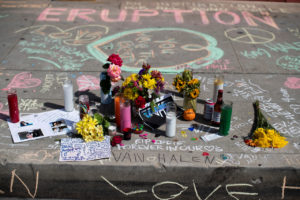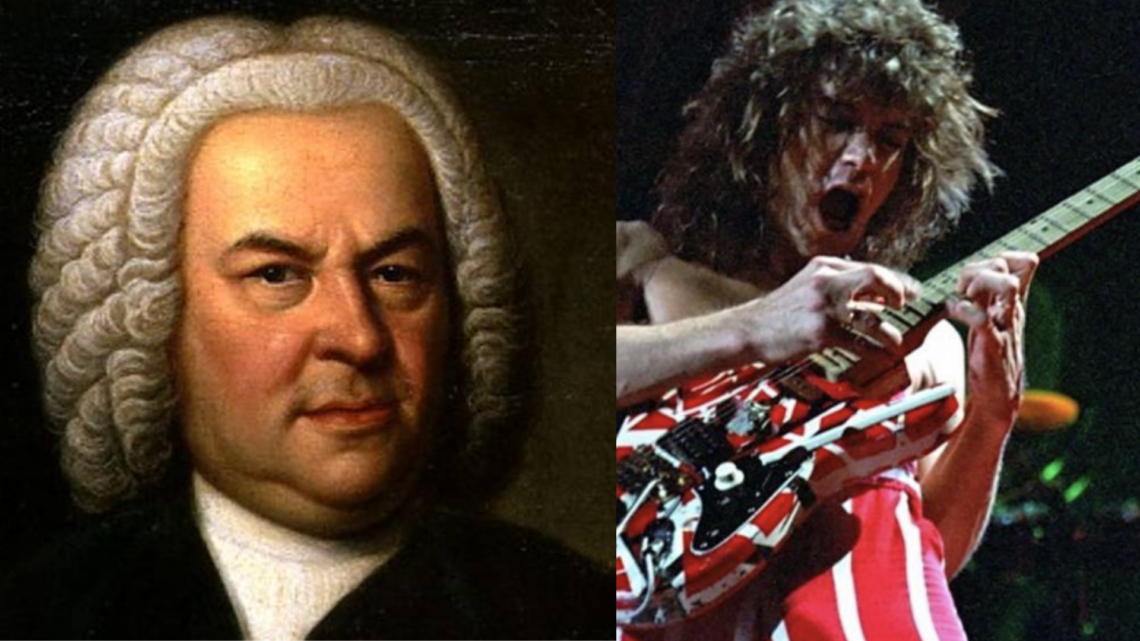Johann Sebastian Bach and Eddie Van Halen. It’s almost 300 years apart, and the style is certainly different. But is there something that links these outstanding musicians and composers together? Photo: Wikipedia – Mediapunch/ REX/ NTB
At first glance, it may seem strange to look for a kinship between the rock guitarist Eddie Van Halen and the baroque master Johann Sebastian Bach. But an unknown piece by Bach made me think of the recently deceased guitar genius.
Just to emphasize: This article is not an attempt to equate Bach and Van Halen. Inspiration can only go one way in history, and while Bach is a giant, Eddie Van Halen is essentially just a very skilled guitarist. But in a moment, I found a point of connection.
Eddie Van Halen
Eddie Van Halen was born in the Netherlands in 1955. His family moved to California in 1962, when Eddie was 6–7 years old. He was the son of a jazz pianist, and his parents wanted to give the children a classical background. Eddie went to an old piano teacher but never learned to read sheet music. His method was to listen to pieces by famous composers, then improvise something using memory. One of the first composers he played pieces from was actually Bach. With his keen understanding of music and good technique, Eddie won a local piano competition three years in a row.
Eddie got tired of the piano and started playing the drums. But since his brother Alex was a better drum player, Eddie switched to the guitar when he was 12. Four years later, he had learned all the solos of his biggest role model: Eric Clapton in Cream.
To make a long story short, Eddie Van Halen gradually developed into one of the world’s foremost guitarists, who could play effortlessly at an insane tempo while mixing a raw expression with almost classical parts.
Eddie and his brother started a band first called Mammoth. But since this band name was already taken, the name changed to Van Halen.
His masterpiece on the guitar already appeared on the debut album, which, creatively enough, was also entitled «Van Halen.»

Very temporary memorial on a sidewalk in Pasadena, after Edward Van Halen died in October 2020. Photo: REUTERS/Mario Anzuoni/ NTB
«Eruption»
«Eruption» wasn’t really supposed to be on the album; it was mostly something Eddie played with at concerts, various themes he improvised around. No two editions were alike. What remained were the many different themes, transitions between brutality and beauty, and frequent use of triplets at a furious pace, performed with surgical precision. Certain parts are clearly classically inspired, other parts sound almost computer-programmed for a few seconds (about 7.00), before Eddie lets the solo take yet another twist.
Eddie uses the now well-known tapping technique, i.e., striking the strings with the fingertips. This was really nothing new. Harvey Mandel from Canned Heat also used the method. Eddie Van Halen is said to have seen Mandel live as a youth. Jazz guitarist Tal Farlow used tapping in the early 20th century. There are more examples I could have mentioned.
The bottom line is: Eddie Van Halen wasn’t the first out. But he popularized and developed this way of playing the solo guitar, and was an early adopter of double tapping, which means that you «play the piano» on the guitar with both hands. This opened up unimaginable possibilities.
The result was, among other things, what is considered one of the best guitar solos ever. This is, of course, a matter of taste and preference. But I haven’t seen many awards that don’t have the Eruption solo among the very best on the list. And since Eddie Van Halen died in October 2020, a tribute is fitting.
Eddie also used the technique on acoustic guitar. And he still makes an impression on young people today.
Eddie was an acquaintance of the legendary Frank Zappa, and his son Dweezil Zappa tells here in a moving clip how generous Eddie was to Dweezil in his youth when he learned to play the guitar, and later how Eddie was a support for Dweezil after his father Frank died. Dweezil ends by playing Eruption, but watch the original below instead.
Incidentally, Eddie Van Halen plays solo guitar on Beat It by Michael Jackson. Eddie is said to have reshuffled much of the arrangement to make the guitar and melody work better together. Eddie’s guitar drives the whole song. Quincy Jones and Jackson were delighted, and most people know the result. Furthermore, no fee was agreed in advance.
Johann Sebastian Bach
The German composer Johann Sebastian Bach (1685–1750) was an organ and harpsichord virtuoso from the Baroque who composed to order at a furious pace. Long after his death, he was best known as the father of his sons Wilhelm Friedemann, Philipp Emmanuel, and Johann Christian. Only later was he recognized as one of the leading composers in the classical European music tradition.
Bach lived in a completely different time and tradition than Van Halen. In the Baroque period, music was subject to stricter rules. Bach developed an almost mathematical form of music, with harmonies and counterpoints where the music consists of independent voices that interact with each other. Bach was also a key contributor to church music.
Throughout his career, Bach was a hired musician, often at various courts or churches. At the start of his career, he was naturally given a number of boring tasks, such as copying sheet music or transcription of, among other things, violin pieces for organ music. Bach worked with Vivaldi’s music, among other things.
But Bach also composed, and the output is massive. In one of these pieces, something that was new to me emerges. I’m talking about the Brandenburg Concerto No. 5 and in particular, the harpsichord solo in the first movement.
The reason why I did not know this piece is probably my lack of knowledge about Bach, which can be explained by the fact that he was not on the playlist at home when I was growing up (it was mostly Mozart, Beethoven, Grieg, Liszt, Chopin, Scott Joplin, and classical jazz). Bach was defined by my surroundings as a bit boring.
The piece was composed when Bach earned a living by performing a number of less exciting tasks in addition to being a musician and composer. The first edition probably appeared around 1710 but was later adapted to technological developments; in particular, that you got a harpsichord with two manuals. The final version was dedicated to Margrave Christian Ludwig of Brandenburg in 1721.
The beginning and end of the first movement are basically by strings. The mood is light, airy, and pretty; one could almost say politically correct by the standards of the time. The inspiration from Vivaldi is noticeable.
But then something happens. It is as if the frustration becomes too great, as if the creative spirit forces itself forward and rebels. It is also a rebellion for the harpsichord, which had a rather anonymous place in the string orchestras of the time. Admittedly, the harpsichordist also often acted as a conductor, but the instrument rarely played the leading role.
This is not an improvisation. Here Bach unleashes the harpsichord on elegantly written notes. Personally, I experience a wildness, an innovation, a tribute to life, a cry for freedom, and a protest against the straitjacket.
It’s like an eruption, a volcano overflowing. So: Eruption. It is, of course, about two completely different musical genres. Not everyone (maybe a few?) likes both of these pieces. But personally, I get the same feeling from hearing this piece by Bach as I do from hearing an impossible solo performed by Eddie Van Halen.
While Bach was at it, he conducted the orchestra and performed the harpsichord solo. But there are few recordings from the 18th century.
If you want to hear the whole piece, there’s a nice performance here. But I focus mostly on the harpsichord part, here excellently performed by Karl Richter, who is also the conductor. Below you can watch Eddie Van Halen play through his “Eruption.”
Support us!


